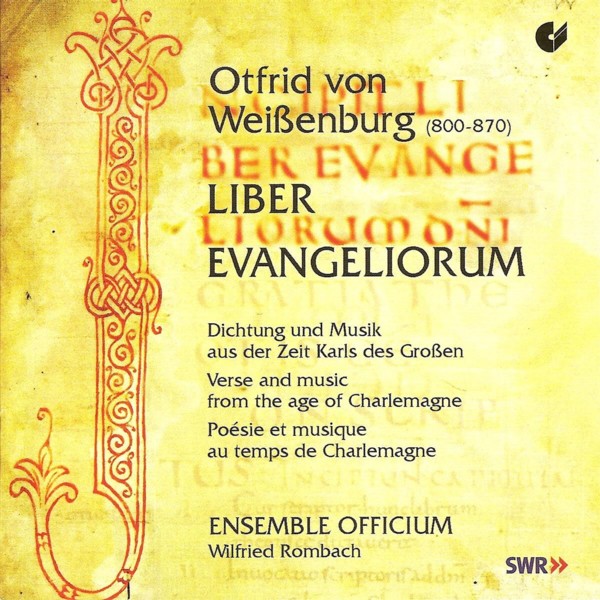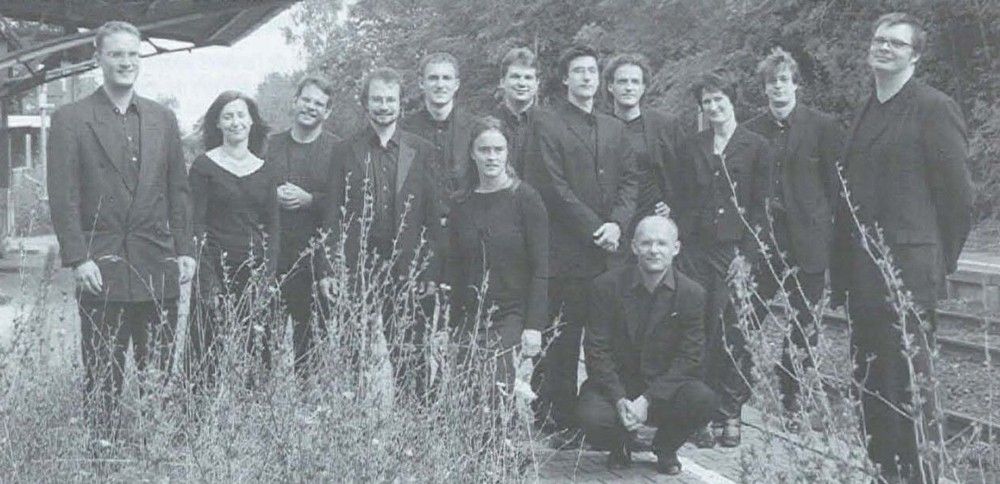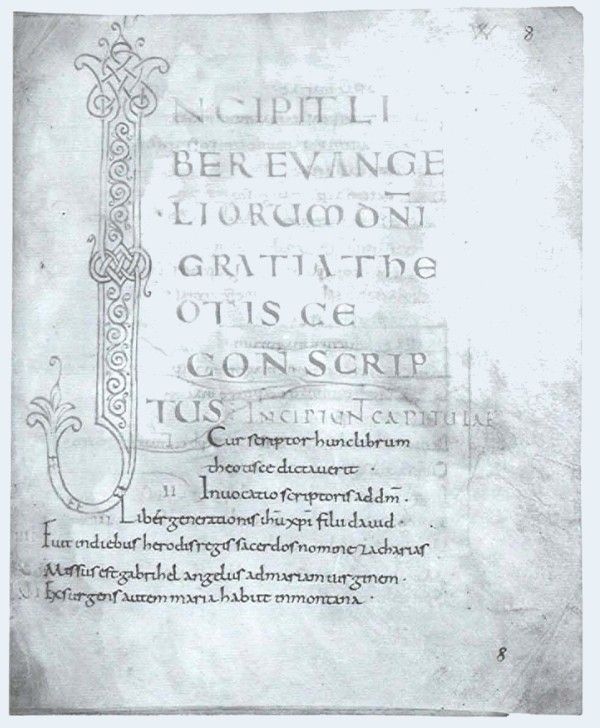
medieval.org
Christophorus CHR 77279
mayo de 2005
Evangelische Kirche, Gönningen

medieval.org
Christophorus CHR 77279
mayo de 2005
Evangelische Kirche, Gönningen
01 - Invocatio. Wola drúhtin min · Invocatio
scriptoris ad Deum (lib.I, cap.II) [1:30]
02 - Invitatorium & Ps 94(95). Præoccupemus
faciem Domini [9:19]
03 - Hymnus. Vox clara ecce intonat · Hymnus im
Advent [2:04]
04 - Lectio I. Thiz sint búah frono · Liber
generationis Jesu Christi NH David (lib.I, cap.III) [3:01]
05 - Responsorium. Aspiciens a longe
· Vigil zum 1. Advent [7:31]
06 - Lectio II. Ward áfter thiu irscrítan sár
· Missus est Gabrihel Angelus (lib.I, cap.V) [2:51]
07 - Responsorium. Sancta et
immaculata virginitas · Vigil zum Weihnachtsfest
[2:33]
08 - Responsorium. Suscipe verbum Virgo Maria ·
Vigil zum 2. Advent [2:50]
09 - Lectio III. Fûar tho sancta Mária
· Exurgens autem Maria abiit in montana (lib.I, cap.VI)
Thó sprah sancta Mária · De cantico
sanctæ Mariæ (lib.I, cap.VII) [3:36]
10 - Responsorium. Beatam me dicent omnes generationes ·
Vigil zum Fest der Heimsuchung Mariæ [2:29]
11 - Responsorium. Ecce apparebit Dominus · Vigil
zum 3. Advent [2:42]
12 - Hymnus. Veni Redemptor gentium · Hymnus im
Advent [3:10]
13 - Lectio IV. Wúntar ward tho máraz ·
Exiit edictum a cæsare augusto (lib.I, cap.XI) [1:41]
14 - Responsorium. O Magnum
mysterium · Vigil zum Weihnachtsfest [3:29]
15 - Responsorium. Beata Dei Genitrix · Vigil zum
Weihnachtsfest [2:05]
16 - Lectio V. Tho wárun thar in lánte ·
Et pastores erant in regione eadem (lib.I, cap.XII) [2:17]
17 - Responsorium. Hodie nobis cœlorum Rex · Vigil
zum Weihnachtsfest [3:41]
18 - Responsorium. Verbum caro factum est · Vigil zum
Weihnachtsfest [4:48]
19 - Lectio VI. Thar was ein mán alter · De
obviatione et benedictione Symeonis (lib.I, cap.XV) [2:15]
20 - Responsorium. Adorna thalamum tuum Sion · Vigil zum
Fest Darstellung des Herrn [4:49]
21 - Oratio. Giwérdo uns geban drúhtin ·
Oratio (lib.V, cap.XXIV) [2:58]
22 - Antiphona. Alma Redemptoris
mater [1:54]

ENSEMBLE OFFICIUM
Wilfried Rombach
Marion Bücher-Herbst & Laila Finvik-Pettersen (Soli)
Miriam Barth, Sibylle Henn, Alena Leja, Christine Rombach
Jörg Rieger & Steffen Doberauer (Rezitationen), Wilfried
Rombach (Soli)
Florian Schmidt, Daniel Herrscher, Jens-Martin Ludwig
Marc Lewon, Uri Smilansky, Elizabeth Rumsey (Fideln)
Leitung / Direction:
Aufnahme: 13.-14.6.2005, Ev. Kirche Gonningen
Tonmeister & Schnitt: Andreas Priemer
Toningenieur: Matthias Neumann
Produzent: Gunilla Gustayson

OTFRID OF WEISSENBURG (c 800 - 870): LIBER EVANGELIORUM
Verse and Music from the time of Charlemagne
by Wilfried Rombach and Marc Lewon
One of the most significant artistic achievements in Carolingian
literature is the Liber evangeliorum by Otfrid of
Weissenburg, a monk (c. 800-870) who lived and worked at the Abbey
of Saint Peter and Saint Paul at Weissenburg (French: Wissembourg) in
Lower Alsace. Otfrid had been a pupil at the renowned Fulda Abbey
School, a centre of religious and spiritual life during the Carolingian
era. The school owed its new prosperity and reputation to the abbot,
Hrabanus Maurus (784-856), a man of learning whose pupils included
numerous scholars and abbots of the Abbey of St. Gallen, as well as
Otfrid of Weissenburg. Otfrid wrote his Liber evangeliorum, his
most important work, between 863 and 871. It is his transposition of
the Bible stories about the life of Jesus from the Latin of the gospels
into the South Franconian dialect of Old High German, a gospel harmony
in which the four gospels are distilled into one narrative. The entire
work is in verse - 7,104 long lines divided into five books comprising
a total of 140 chapters. In the 9th century it was highly unusual for
vernacular literature to be written down. The close association between
Latin and the written word, which had existed in western Europe since
the days of antiquity, meant that applying Latin characters to
vernacular language was no easy feat. There was, after all, no system
of grammar and no standardised spelling. The task of writing a whole
book in this way was pioneering work, and it resulted in the earliest
substantial text in Old High German still in existence.
We see from Otfrid's opening remarks and dedications at the start of
the work that he was aware of the novelty and vulnerability of his
project. Whilst admitting that the Franconian language is still
"boorish" and does not follow the rules of (Latin) grammar, he
nevertheless recognises its hidden potential and calls for his language
to be accorded the same respect (as Latin):
It [Franconian] has not yet been used for verse in the fashion
aforesaid, it is true, and it does not yet obey the rules; however, it
too conforms to a pattern, in its agreeable simplicity. Strive with the
utmost zeal, therefore, to make it sound beautiful, so that God's
command may resound wonderfully within it [...]
Despite Otfrid's assertion, contemporary vernacular verse did already
exist, although it was not based on Latin grammar or classical
versification and it was not written down. It seems that it was this
kind of heroic poetry and shorter songs in the vernacular that prompted
Otfrid to undertake his gospel harmony:
When once the ears of splendid men were afflicted by worthless nonsense
and vulgar singing by laymen disturbed their pious frame of mind, a
number of my fellow brothers asked me [...] to write a gospel harmony
in the vernacular, so that the rendition of this holy text might, in
some small way, restrain the enjoyment of worldly songs [...]
Otfrid views the Franks, and thus their verse, as successors to the
glorious ancient civilisations and their literature. His aim is to make
the holy texts accessible to a broader section of society, to those
ignorant of Latin, and at the same time to help the Franks establish a
literature of their own - the only accomplishment in which they
remained, in his opinion, inferior to the ancient civilisations. He
therefore "invents" a new form for his work, combining the medium of
traditional Germanic poetry with the more even metres of Latin verse
and the stylistic device of the end rhyme. The use of the end rhyme as
a defining structure for verse was something new - it had been known as
a rhetorical effect since antiquity, but it was not used as the
systematically recurring structure that we have now come to regard as
almost the definition of poetry. Otfrid's end rhymes are often,
admittedly, merely assonances - lines of verse whose endings sound
similar - and they are free of the constraints of strict rhyme, which
eventually became the model during the High Middle Ages. In Germanic
oral literature, the alliterative long line was the norm, and Otfrid
now crowns this with the end rhyme - to distinguish his work formally,
perhaps, from secular, vernacular verse, to make it "better". He
retains the long verse line structure, however, and the traditional,
alliterative stave rhyme also continues to come through in many
passages, often the more poetic ones, such as the chapter which
includes the Annunciation.
From Weissenburg Abbey, Otfrid cultivated close contacts with important
figures at the famous Abbey of St. Gallen all his life, and he
dedicated the Liber evangeliorum to two St. Gallen friends,
Hartmut and Werinbert. It is possible that the copy preserved today in
Heidelberg University Library (Cod.Pal.lat.52) is the manuscript
originally found at the Abbey of St. Gallen. This hypothesis is
supported by the existence of neume notations above some of the verses,
the same symbols used by the scribes at St. Gallen for notating
Gregorian chant. These neumes provide unique information about the
articulation and interpretation of the melodies. We can therefore
assume that not only were extensive sections of Otfrid's verse sung, as
was customary with medieval verse, but that the Liber evangeliorum
was also probably used for text readings during the liturgy.
On this basis, ensemble officium has attempted to
reconstruct the musical setting of the Liber evangeliorum texts,
bearing in mind the variety of possibilities as to how the recitations
might have sounded. On this recording liturgical models of recitation
and reading are used for the majority of the readings. Passages of text
which are particularly fine, however, receive an embellished melodic
treatment based on the reconstruction by Ewald Jammers, while
incorporating some contextual changes and text-based adaptations. Ewald
Jammers first attempted to reconstruct the melodies from the neume
symbols in the Heidelberg manuscript in 1957.
This recording, the first, aims to place the Liber evangeliorum
in a liturgical context, to show how it might have been used and to
create an exciting relationship between the two. Otfrid's verse is
complemented by Gregorian chant - sung from a liturgical manuscript
written around 1000 by Hartker, a recluse who had himself immured in
his cell at the Abbey of St. Gallen for thirty years. The Antiphonarium
officii (Cod.Sang.390/391), which was written there, is one of the
most important musical manuscripts of the Middle Ages. His script, his
illuminations and his neume notation all show astonishingly high
standards of craftsmanship, musicality and discipline. The music in the
two manuscript volumes is not written in the notation familiar to us
today but uses the same symbols above the liturgical text as those
found in the Otfrid manuscript in Heidelberg. Although these neumes
only give a rough indication of the melodic line, they give its agogic
accentuation all the more clarity. The very elaborate night vigil
responsories in the Antiphonarium officii tend to be based on
Old Testament texts and provide a commentary on the New Testament
message of the Otfrid readings. The result is a programmatic setting
closely resembling the vigils at an abbey.
We begin with the Invocatio [1], the author's plea for the
ability to portray the life of Christ truthfully and with humility.
Tellingly, Otfrid borrows his formulation from the opening part of the
liturgy of the hours, which is traditionally introduced by the
twice-repeated invocation "O Lord, open thou my lips" (Psalm 51,15).
The following invitatory Præoccupemus faciem [2] consists
of an antiphon and the solemn recitation of Psalm 95, performed here by
two female vocalists in alternation. Since time immemorial, this too
has been a fixed part of the opening to the morning liturgy of the
hours. Like the preceding invitatory, the hymn Vox clara ecce
intonat [3], a first high point in the introduction to lauds, also
comes from the Advent vigil liturgy.
The readings selected for this recording are taken exclusively from the
first book of the Liber evangeliorum, which is devoted to the
Christmas story. The narrative is based on Matthew 1,1-17 and begins
with the Liber generationis [4], a rendition of the genealogy
of Jesus from Adam through Noah, Abraham and David to Mary (slightly
abbreviated for this recording). This text is articulated in "tonus
lectionum", a style of intonation still used in the delivery of
liturgical readings today. The assembled monks would answer with Aspiciens
a longe [5], the first responsory in the Advent Sunday vigil and
thus the first freely written and composed canticle of the new Church
year, whose high level of artistry and unusual length reflected its
status in the calendar.
The next reading, Missus est Gabrihel angelus [6], is dedicated
to the well-known prayer "Ave Maria". Like a medieval painter, Otfrid
describes every detail of the encounter between Mary and the angel
Gabriel. Musicological research into Otfrid of Weissenburg's gospel
harmony centres on this fifth chapter of the first book. The presence
of neumes, mentioned earlier, above verses 3 and 4 in the Heidelberg
manuscript suggests that the Liber evangeliorum was also sung. A
possible explanation for the autonomous musical arrangement indicated
here by the neumes is that this especially poetic chapter may have been
written as a separate "Canticum" before the Gospel Book was completed.
In his analysis, Ewald Jammers believes he can detect the recitation
tone "accentus Moguntinus", which was in use in the Archdiocese of
Mainz (including Weissenburg Abbey) during the Middle Ages. We have
therefore set this whole reading to that melody.
The reading Exsurgens autem Maria [9] draws together two
chapters (I,6 and I,7) of the Gospel Book. lt describes the scene in
which Mary visits her cousin, Elisabeth, and is transported by emotion
to sing the visionary Magnificat. Because the text of this canticle is
one of the most important in the liturgy and has inspired great
compositions throughout history, it is given special treatment on this
recording, though with no claim to authenticity. The responsory which
follows, Mariæ Beatam me dicent [10], is also based on
the text of the Magnificat and is taken from the vigil of the
Visitation of Mary.
The well-known Advent hymn Veni redemptor gentium [12] marks
the beginning of the second part of the recording and of the Christmas
story itself. In keeping with the practice of solemnly reading the
Christmas gospel on Christmas Eve, the reading Exiit edictum a
Cæsare Augusto [13] is recited in the sung gospel tone. It is
followed by what is surely the most fervent Christmas song of the
Middle Ages, the responsory O magnum mysterium [14]. The
reading Et pastores erant in regione eadem [16] is an almost
unsurpassably vivid description of the scene in which the angel appears
to the shepherds in the field, bringing news of the Saviour's birth.
Although very little is known about the use of instruments in church,
medieval writings are littered with prohibitions on the use of
instruments in the liturgy. The human voice was the ideal in liturgical
music, the only "instrument' worthy of praising God. However, the
constant repetition of such bans might also suggest that instruments
were in fact widely used in religious music. We decided in favour of
using instruments for the purely acoustic medium of a CD on aesthetic
grounds. This recording features three fidels recreated from medieval
representations: sculptures in Chartres Cathedral dating from the end
of the 12th century and an image in a Bible dating from the middle of
the 12tha century (London, British Library, Harleian Ms. 2804).
The most striking feature of the Christmas vigil responsory Verbum
caro factus est [18] is its jubilus, a melodic embellishment of the
final syllable. This form is rather atypical of the liturgy of the
canticles of the hours, but it doubtless symbolises the infinite joy
over Christ's incarnation and the beginning of the salvation of God's
peopie. The scene described in the reading De obviatione et
benedictione Symeonis [19] once marked the end of the Christmas
season. On a visit to the temple, the aged Simeon praises God for
fulfilling his promise about the Messiah and prophesies the Passion of
Christ. His hymn of praise, the "Nunc dimittis", is one of the most
important prayers in the liturgy. It is used daily by priests and monks
in the liturgy of the hours at compline. The event is also celebrated
by the present-day Church on 2 February under the name of "The
Presentation of the Lord in the Temple" (previously Candlemas). The
final Oratio [21], which is taken from the fifth book (V,24),
and marks the end of the life and work of Jesus, is followed by the
Marian antiphon Alma redemptoris mater [22]. As the concluding
canticle, this traditionally ends the compline service and brings the
monks' day at the abbey to a close.
translation: Debbie Hogg